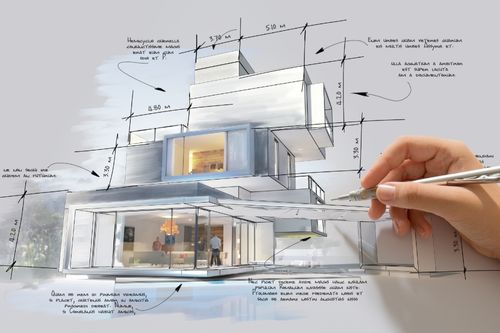The Essential Function of an Architect fit Sustainable Urban Atmospheres for Future Generations
The function of a designer in crafting lasting urban atmospheres is increasingly essential in responding to the obstacles of environment change and urbanization. By effortlessly integrating ecological concepts right into their styles, architects not just improve the aesthetic and functional high quality of urban spaces but also address pushing problems such as energy efficiency and social equity.
Recognizing Lasting Urban Layout
Sustainable metropolitan style integrates environmental concepts with city preparation to develop settings that are not only comfortable yet likewise resistant. This strategy emphasizes the significance of incorporating natural systems right into the urban material, ensuring that advancement meets the needs of today without jeopardizing the ability of future generations to meet their very own demands. Key aspects of lasting city layout include efficient land usage, the promotion of biodiversity, and the assimilation of eco-friendly rooms, every one of which add to boosted lifestyle for residents.
Additionally, lasting metropolitan design focuses on the reduction of the urban warm island impact, improved air high quality, and efficient stormwater management. It urges using renewable energies and energy-efficient structure practices, which considerably lower carbon footprints. Sustainable city style cultivates social equity by producing obtainable public areas and advertising mixed-use growths that provide to diverse populations.
Through thoughtful planning and cutting-edge design methods, sustainable metropolitan settings can boost community strength against environment modification while fostering financial development. This holistic technique not only addresses instant city difficulties yet also lays the groundwork for much healthier, more lasting cities for generations to find.
Trick Responsibilities of Engineers
Designers play a critical duty in forming sustainable metropolitan environments by converting layout concepts right into substantial structures and rooms. Their duties include a wide variety of activities that add to the total success of urban design jobs.
Primarily, architects carry out thorough site analyses to understand the ecological, social, and social context of their projects. This fundamental understanding notifies their layout choices, ensuring that buildings harmonize with their environments. They also take part in collective procedures with stakeholders, including city organizers, engineers, and the community, promoting an inclusive approach to metropolitan growth.
In addition, engineers are entrusted with creating styles that optimize energy efficiency, source conservation, and performance. They have to stick to local zoning legislations, constructing codes, and sustainability certifications, making sure compliance while pushing the limits of technology.
In addition, architects are in charge of taking care of the design process, coordinating with different experts throughout the building stage to make certain that the vision is understood accurately (cda architects). Inevitably, their role is not entirely regarding appearances; it is regarding producing resilient, flexible rooms that improve the lifestyle for existing and future generations, laying the groundwork for lasting city find more living
Cutting-edge Products and Techniques

Additionally, innovations in technology have led to the advancement of high-performance products, such as shielded concrete types (ICFs) and solar glass, which add to power preservation and harness renewable resource. Techniques such as passive solar layout and environment-friendly roofs even more exemplify how architecture can balance with natural systems, minimizing dependence on fabricated heating and air conditioning.
In addition, the combination of smart materials, which adapt to environmental modifications, uses promising opportunities for enhancing structure efficiency. These products can reply to temperature level fluctuations or dampness levels, enhancing comfort and sustainability.
Ultimately, the strategic choice and application of ingenious products and techniques empower designers to produce urban areas that are not only practical and aesthetically pleasing but additionally resistant and environmentally liable, guaranteeing a sustainable future for generations ahead. cda architects.
Community Engagement and Cooperation
The success of ingenious materials and techniques in lasting city architecture is significantly enhanced by energetic area interaction and partnership. Engineers must acknowledge that the constructed atmosphere exceptionally description influences the lives of neighborhood citizens, making it important to entail them in the design procedure. Involving the community fosters a feeling of ownership and liability, making certain that developments not just satisfy visual and practical requirements yet likewise mirror the worths and aspirations of those that inhabit them.

Successful area involvement also assists in focusing on social equity within urban advancement. By considering the voices of marginalized populations, engineers can produce spaces that are comprehensive and equitable. By doing this, area interaction and partnership come to be indispensable to accomplishing really lasting urban atmospheres that serve the needs of present and future generations.
Future Fads in Lasting Design
An emerging focus on flexible reuse and circular economic situation principles is established to redefine the landscape of lasting style. As cities come Discover More to grips with boosting population densities and ecological obstacles, designers are progressively transforming to approaches that enhance existing frameworks as opposed to going after brand-new builds. This strategy not just maintains cultural heritage however additionally substantially reduces source consumption and waste.
Additionally, advancements in modern technology are forming future fads in lasting architecture. The combination of clever products and building systems enables for real-time power monitoring, improving performance and lowering carbon impacts. Developments such as green roofs, living wall surfaces, and energy-generating facades are becoming common techniques, additionally promoting eco-friendly balance within urban environments.
Furthermore, a shift in the direction of biophilic design is obtaining grip, emphasizing the connection between nature and human health. By including all-natural components, architects develop rooms that promote mental health and wellness while advertising biodiversity.
Conclusion
To conclude, architects are critical beforehand sustainable city environments via their expertise in style, cutting-edge products, and community involvement. By prioritizing power efficiency and resource conservation, these specialists add to the development of durable city areas that meet the requirements of present and future generations. The integration of environmental principles not only boosts livability but likewise promotes social equity, making certain advancements resonate with the worths and ambitions of the communities they serve.